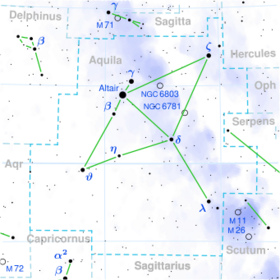Astronomy:Nu Aquilae
| Observation data Equinox J2000.0]] (ICRS) | |
|---|---|
| Constellation | Aquila |
| Right ascension | 19h 26m 31.08926s[1] |
| Declination | +00° 20′ 18.8549″[1] |
| Apparent magnitude (V) | 4.72[2] + 9.6[3] |
| Characteristics | |
| Spectral type | F3 Ib[4] + A1 IV/V[3] |
| U−B color index | +0.60[2] |
| B−V color index | +0.59[2] |
| Astrometry | |
| Radial velocity (Rv) | –2.30[5] km/s |
| Proper motion (μ) | RA: −0.562[1] mas/yr Dec.: −2.294[1] mas/yr |
| Parallax (π) | 0.8752 ± 0.0869[1] mas |
| Distance | 3,700 ± 400 ly (1,100 ± 100 pc) |
| Absolute magnitude (MV) | −5.58[6] |
| Details | |
| Mass | 12.5[4] M☉ |
| Radius | 71.20+14.45 −10.23[7] R☉ |
| Luminosity | 7,645±1,464[7] L☉ |
| Surface gravity (log g) | 1.43[4] cgs |
| Temperature | 6,396+516 −564[7] K |
| Metallicity [Fe/H] | −0.03[8] dex |
| Rotational velocity (v sin i) | 13[9] km/s |
| Age | 15[4] Myr |
| Other designations | |
| ν Aql A: {{{names1}}} | |
| ν Aql B: {{{names2}}} | |
| Database references | |
| SIMBAD | data |
Nu Aquilae, Latinized from ν Aquilae, is the Bayer designation for a double star in the constellation of Aquila that lies close to the celestial equator. It has an apparent visual magnitude of 4.72 and so is visible to the naked eye. Based upon an annual parallax shift of only 0.8752 mas (with a 10% margin of error), it is believed to lie approximately 3,700 light-years (1,100 parsecs) from Earth.[1] The variable star NU Aquilae has a similar-looking designation but is a separate and unrelated object.
The spectrum of ν Aql A matches a stellar classification of F3, with the luminosity class of Ib indicating this is a supergiant. This is a massive star, with approximately 12.5 times the mass of the sun,[4] and it spans ~71 times the Sun's girth.[7] It is only 15[4] million years old and is radiating around 7,600 times the luminosity of the Sun.[7] The outer atmosphere has an effective temperature of 6,700 K and it has the yellow-white hue of an F-type star.[10]
ν Aql B is a ninth magnitude star 201 arc-seconds distant.[11] Little is known about it except an approximate spectral classification.[3]
References
- ↑ 1.0 1.1 1.2 1.3 1.4 1.5 Brown, A. G. A. (2021). "Gaia Early Data Release 3: Summary of the contents and survey properties". Astronomy & Astrophysics 649: A1. doi:10.1051/0004-6361/202039657. Bibcode: 2021A&A...649A...1G. Gaia EDR3 record for this source at VizieR.
- ↑ 2.0 2.1 2.2 Ducati, J. R. (2002). "VizieR Online Data Catalog: Catalogue of Stellar Photometry in Johnson's 11-color system". CDS/ADC Collection of Electronic Catalogues 2237. Bibcode: 2002yCat.2237....0D.
- ↑ 3.0 3.1 3.2 Burnichon, M. L. (1975). "Investigations on the intrinsic properties of high-luminosity blue stars inferred from observations of multiple systems". Astronomy and Astrophysics 45: 383. Bibcode: 1975A&A....45..383B.
- ↑ 4.0 4.1 4.2 4.3 4.4 4.5 Lyubimkov, L. S. et al. (2010). "Accurate fundamental parameters for A-, F- and G-type Supergiants in the solar neighbourhood". Monthly Notices of the Royal Astronomical Society 402 (2): 1369–1379. doi:10.1111/j.1365-2966.2009.15979.x. Bibcode: 2010MNRAS.402.1369L.
- ↑ Gontcharov, G. A. (2006). "Pulkovo Compilation of Radial Velocities for 35 495 Hipparcos stars in a common system". Astronomy Letters 32 (11): 759–771. doi:10.1134/S1063773706110065. Bibcode: 2006AstL...32..759G.
- ↑ Kovtyukh, V. V; Chekhonadskikh, F. A; Luck, R. E; Soubiran, C; Yasinskaya, M. P; Belik, S. I (2010). "Accurate luminosities for F-G supergiants from FeII/FeI line depth ratios". Monthly Notices of the Royal Astronomical Society 408 (3): 1568. doi:10.1111/j.1365-2966.2010.17217.x. Bibcode: 2010MNRAS.408.1568K.
- ↑ 7.0 7.1 7.2 7.3 7.4 Brown, A. G. A. (August 2018). "Gaia Data Release 2: Summary of the contents and survey properties". Astronomy & Astrophysics 616: A1. doi:10.1051/0004-6361/201833051. Bibcode: 2018A&A...616A...1G. Gaia DR2 record for this source at VizieR.
- ↑ Lyubimkov, Leonid S; Lambert, David L; Korotin, Sergey A; Rachkovskaya, Tamara M; Poklad, Dmitry B (2015). "Carbon abundance and the N/C ratio in atmospheres of A-, F- and G-type supergiants and bright giants". Monthly Notices of the Royal Astronomical Society 446 (4): 3447. doi:10.1093/mnras/stu2299. Bibcode: 2015MNRAS.446.3447L.
- ↑ Bernacca, P. L.; Perinotto, M. (1970), "A catalogue of stellar rotational velocities", Contributi Osservatorio Astronomico di Padova in Asiago 239 (1): 1, Bibcode: 1970CoAsi.239....1B.
- ↑ "The Colour of Stars", Australia Telescope, Outreach and Education (Commonwealth Scientific and Industrial Research Organisation), December 21, 2004, http://outreach.atnf.csiro.au/education/senior/astrophysics/photometry_colour.html, retrieved 2012-01-16
- ↑ Mason, Brian D. et al. (2001). "The 2001 US Naval Observatory Double Star CD-ROM. I. The Washington Double Star Catalog". The Astronomical Journal 122 (6): 3466. doi:10.1086/323920. Bibcode: 2001AJ....122.3466M.
External links
- Kaler, James B., "Nu Aquilae", Stars (University of Illinois), http://stars.astro.illinois.edu/sow/nuaql.html, retrieved 2017-11-16
- Image ν Aquilae
- HR 7387
- CCDM 19265+0021
 |


